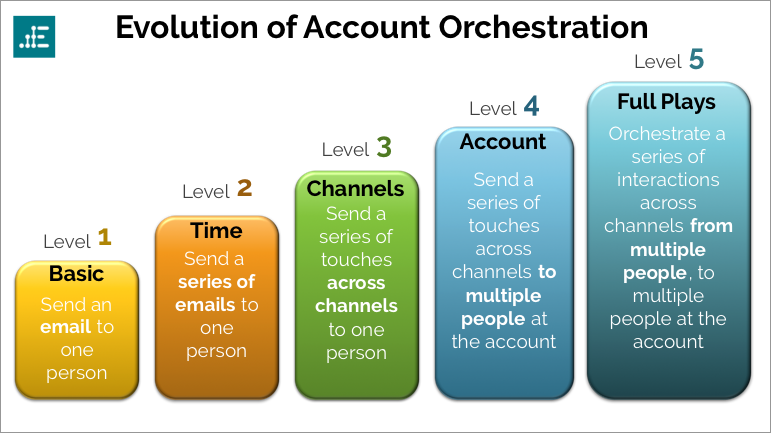One of the biggest challenges organizations face (always) is aligning marketing and sales. In truth, only a fourth believe they’ve achieved it.
Perhaps alignment isn’t the real issue, though.
To take it back a step, if Marketing can figure out how to scale account-based programs, and do it in a coordinated (between Sales and Marketing), measurable way — alignment would easily follow.
With that in mind, I’m going to give you a proven system to execute and automate account-based programs that get real results. We’ll look at:
- 7 steps to successfully scale account-based programs
- ABM maturity model
- The most relevant and valuable outreach wins
But first, for those who may not be as intimately familiar with account-based strategies, let’s define what we’re talking about.
What Are Account-Based Strategies?
Account-based strategies are personalized, multi-channel, multi-threaded, outbound activities aimed at creating high-value opportunities in new and existing customers.
Over the years, I’ve seen many companies jump onto the account-based bandwagon and claim they do ABM and ABS (or have features that support it).
But here’s the truth: ABM is not a tactic, tool or campaign. It’s an entire go-to-market strategy.
Related: Everything You Need to Know About Account Based Sales [Guide]
A tool doesn’t make a strategy. You must put strategy first, then figure out which tools, tactics, and campaigns will best support that strategy.
7 Steps To Successfully Scale Account-Based Programs
Building processes into your work is how you scale things. And when we look at the most successful ABM and ABS practitioners, a pattern emerges.
Most account-based journeys follow a seven-step process:
1) Select accounts: Align Sales and Marketing around a list of target accounts that are most likely to deliver revenue, and tier those accounts based on entitlements.
2) Identify people: Find the account’s buying contacts for your key personas, based on your ideal buyer profiles. (Bonus: Learn 4 Surprising Places to Find Warm Leads )
3) Develop account insights: Learn what matters at each account so your interactions are relevant and resonant.
4) Generate account-relevant messages and content: Create or adapt content and messaging that reflects your account insight and is targeted specifically at the buying teams in each account.
5) Deliver account-specific interactions: Manage targeted interactions that are personalized for each account.
6) Orchestrate account-focused plays: Synchronize interactions into coordinated plays that align with account plans and goals.
7) Measure account progress: Report on the impact of ABM efforts in terms of account engagement, impact on pipeline and revenue, and program ROI.
RELATED: Making the Business Case to Eliminate Lead Gen Forms in Your ABS/ABM Strategy
ABM enables one-on-one interactions that can build relationships with prospects and ensure success with customers.
It works because it fosters real and authentic human engagement. Sales can maintain control of their high-value accounts, while Marketing coordinates and plans touches that are executed by front line teams.
To be effective, programs must be:
- Targeted – aimed at selected, named accounts, not huge, undifferentiated lists
- Personalized – based on relevant, crafted conversations instead of standard, one-size-fits-all scripts
- Researched – driven by systematic insight generation (not two minutes on LinkedIn
- Multi-channel – maximizing reach by using all channels, not massive spamming campaigns
- Integrated – a coordinated effort supported by marketing, not another silo
- Relevant to the key contact in the account
- Extended throughout the entire lifecycle of the account, from acquisition to advocacy
ABM Maturity Model
There are differing levels of sophistication in your ABM and ABS programs. The more advanced, the more orchestration and coordination are necessary.
Here’s how we think of it at Engagio.

Level 1 – Basic: Send an email to one person
Level 2 – Time: Send a series of emails to one person
Level 3 – Channels: Send a series of touches across channels to one person
Level 4 – Team: Send a series of touches across channels from multiple people and teams.
Level 5 – Full plays: Orchestrate a series of interactions across channels from multiple people to multiple people at the account.
The best account-based programs at the highest level reach people at the right time with relevant, personalized touches that drive engagement.
Hint: It’s about engagement.
The Most Relevant and Valuable Outreach Wins
All of this is great, but it doesn’t mean anything if the content of your message doesn’t resonate. So, let’s first take a look at the content you need for your initial cold outreach emails, then we’ll dive into the content you need for your follow-up emails.
Initial Cold Outreach Content
When you’re thinking about your first touch, what matters is why you’re reaching out. You need a credible reason for touching base.
The most effective way to break into a new account and get a conversation started is to leverage a trigger event. Simply put, this is any event that gives you a good reason to reach out.
For example, job changes are powerful trigger events.
I was recently chatting with Craig Elias, author of a great sales book titled SHiFT! He explained that, depending on industry and geography, data suggests a change in vendors is triggered by changing account managers 28% of the time.
Combining this knowledge with a technology that monitors changes in job titles can be a powerful one-two punch.
There are two types of trigger event:
- Organizational trigger events
- Personal trigger event
As the name suggests, organizational trigger events are generated by changes at the organizational level, while personal trigger events are at the contact level.
Some of our reps have found that personal trigger events tend to be more powerful and effective, so they like to prioritize them first.
RELATED: 3 Ways Sales Can Use a CDP to Improve Account-Based Selling
Here is a list of trigger events that would prompt your team to launch an appropriate play to capitalize on the event:
Organizational Trigger Event
- Job postings
- Funding announcements
- 10-K filing (if they’re a publicly traded company)
- New product announcements
- Technology (i.e., they’re using a competitive or complementary product)
- Usage (e.g., if someone hasn’t logged in for 10 days)
Personal Triggers Events:
- Promotion or new role
- Published content
- Attended event
- Behavioral triggers Content interaction (e.g., watched webinar, downloaded ebook, etc.)
- Company engagement (e.g., visited five marketing webpages)
- Social engagement (e.g., tweeted about a keyword)
If you’re prospecting into an account and don’t see any trigger events to leverage, it’s time to start looking for other door openers.
Door openers are points of affinity or mutual connections. Shared interest (same college, sports team, etc.), if used properly, can be a powerful way to build trust and rapport.
Follow-up Content
The content of your outbound efforts is a critical determining factor in whether you come across as an annoying pest or a persistent, respected guest. Follow up messages that say “just checking in” or “just following up” will get you forever condemned to the spam folder.
John Barrows, a well-known sales trainer and author states,
“The phrases ‘touching base’ and ‘checking in’ are two of the most meaningless phrases in sales. It means there’s no reason for your call, so therefore there’s no reason for me to talk to you.”
How do you fix this grievous error? Offer value at every touch. Barrows suggests leading with, “The reason for my call is…”
Can’t finish that sentence? Then don’t reach out!
Here are four reasonable and justifiable reasons for following up with a target prospect:
Reemphasize business value – What can you do for the prospect? You must find a way to provide value. Speak to their fears and frustration or wants and aspirations.
Provide commercial insights – Studies by the ITSMA prove that “75% of executives will read unsolicited marketing materials that contain ideas that might be relevant to their business.” Share a different way to approach their problems or a novel idea for how they can reach their business goals.
Teach/educate – Offer a piece of valuable content, that your marketing team has provided you. It could be anything from a whitepaper or ebook to webinar or case study.
Offer relevant news – Savvy business people love to stay up-to-date with the latest on what’s happening in their industry or market. They’ll thank you for it, and you’ll be positioned as a trusted expert and in-the-know.
Personalization
One of the most frequent questions we get about content is, “How much personalization is necessary?”
The more personalization, the better. However, that’s not always scalable.
RELATED: How to Personalize Your Outbound Approach According to Your Market and Persona
Here’s our rule of thumb for personalization: The more important the account or the contact, the more you want to personalize and the less you want to use a template. The degree of personalization will depend on the importance of the account and the person you’re targeting.
- Tier 1: Highly personalized, with little or no templating
- Tier 2: Personalized, perhaps using the 10/80/10 approach: Customize the first 10%; Use the template for the next 80% (with possible personal tweaks); Customize the last 10%
- Tier 3: Customized rather than personalized (e.g., targeted to their industry and persona, uses their name and company name)
Your goal is to make sure the prospect feels like the email really is written to him or her, as an individual. If they don’t feel that way, and instead feel like they’re part of a bulk mailing, you’re doing it wrong.
For that to happen, it must be obvious that you’ve been thinking about them.
ABM Success = Technology + You
Using the right technology can get you halfway there by providing intelligence and automation, which gives you the ability to create templates and send more outbound emails. But that’s only part of the puzzle. The other part is incorporating personalization, which gives it the human touch.
Technology and automation should enhance your efforts, not replace them.
Is ABM in your playbook? What are you best tips for connecting with target accounts?







